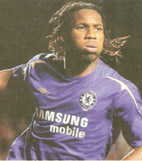
THE 26th AFRICAN CUP OF NATIONS
By Nathan Mbatia
The 26th edition of the African nation’s cup took place in Ghana from 20 January to 10 February 2008, and what an event it was. Ghana proved to be the perfect host with a very colorful opening ceremony and a good show of football by their national team, which finished third overall despite missing their talismanic captain Stephen Appiah due to a long-term knee injury. The games were played in Kumasi in the Baba yara stadium, which has a 40 000-spectator capacity. Others were played in the Ohene Djan stadium in the capital Accra that hosted both the opening and final matches while others were played at the 20 000 seater Tamale and Sekondi stadia.
Sixteen of the best footballing nations qualified after a grueling qualifying campaign throughout all of Africa. There were no major upsets in the qualifying rounds even though Togo, one of Africa’s representatives in the World cup did not make it to Ghana.
The overall standard of the tournament was satisfactory because this ended up being the highest scoring tournament in history with 99 goals scored. There was no match that ended with the dreaded penalty shoot out that we have so often seen turning heroes to villains. The tournament saw two individuals enter the African football record books.
Egyptian head coach Hassan Shehata became only the second coach to win the tournament back to back after Charles Kumi Gyamfi did it with Ghana in 1963 and 1965. The latter though holds the record for the most wins by a coach for he won it again for Ghana in 1982. F.C Barcelona star striker Samuel Fils E’to became the highest tournament goal scorer by reaching the 16 goals mark to surpass Ivorian legend Laurent Mpoko Ntii whose record stood at 14 goals. Egypt as a nation also became the country with the most wins after winning it for a record sixth time.
Cameroon finished second after veteran defender Rigobert Song’s dreadful mistake gifted Egypt the winning goal of a final that the Egyptians dominated in ball possession. This was their second loss to the Pharaohs in the tournament after a 4-2 loss in the opening group game of both teams. Egypt seems to be the bogey team for the Cameroonians as it was the one that held Cameroon to a 1-1 draw thus knocking them out of the 2006 World Cup qualifying campaign when their making it to Germany had looked almost certain. Host Ghana came a respectable third even though their dream was to win it on home soil. They were eliminated by Cameroon at the semi final stage where they conceded a single goal.
Ivory Coast only came fourth but had a good tournament living up to their billing as one of the best teams in Africa. It all seemed to go wrong for them when they played Egypt in the other semi final losing 4-1. Senegal and South Africa disappointed even though the latter claimed to have been building a team for the 2010 World Cup, which they will be hosting. Nigeria too were unimpressive and had to rely on the outcome of another match to make it to the second round where they lost to Ghana. Morocco did not make it to the second round either after overwhelming Namibia 5-1 in their first group game. Namibia went on to lose 1-0 to Ghana in their second match where they played their hearts out and drew one all with Guinea in their last group game.
Some good individual performances caught one’s eye. Pascal Feunduno of Guniea did well even though he was red-carded against Morocco; Manucho of Angola looks to be a striker with a bright future hence his being signed by Manchester United. Mohamed Zidan of Egypt is worth mentioning too, so is Cameroonian keeper Idriss Kamene. Alexander Song is another youngster who did well and lastly but not certainly the least is Namibian Brian Brendell who scored both goals that Namibia managed to score in the tournament. Overall, the tournament was very entertaining and showed how far African football has come, and gives us hope of good representation come 2010 in South Africa no matter who qualifies to represent the continent. We therefore take our hats off to CAF and Ghana as a whole for a well-organized football feast.
 ....................
....................
Michael Esien (left) and Didier Drogba (right)
Disclaimer: The materials hosted on our site are products and sole responsibility of respective publishers and do not necessarily represent the views of The African Magazine nor its employees...
©2007 The African Magazine All Rights Reserved